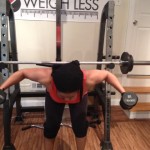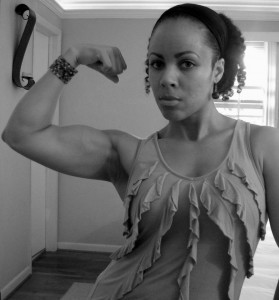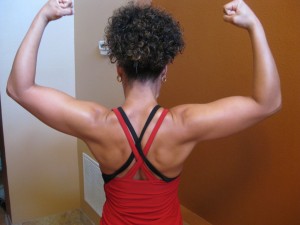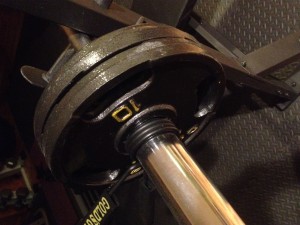by EM2WL | Feb 19, 2012 | Building Muscle, Fitness Cycles (Periodization), Increasing calories, Metabolism Reset, Q & A
Q: Seems like more and more people are “bulking,” I guess I’m wondering if I’m missing out on some hidden benefit of it. I get that it helps to put on muscle (muscle building), but I don’t think I would ever see the need for it in my life. What is the point of bulking? It almost seems like another yo-yo dieting trap. I mean, I guess I understand for a person that’s skinny, or at goal weight, but I’m a lot farther away from my goal than I’d like to be, and can’t imagine purposely putting on extra weight. What type of person (other than a bodybuilder, lol) should consider bulking or muscle building?
A: Bulking (eating above maintenance, while lifting heavy weights) can be beneficial to a variety of people, not just the skinny ones, lol. When I first began my “bulk/cut” cycles, I wasn’t at goal weight either (although I’d be the first to admit, that it may have been a lot easier if I was). But, learning the the benefits of it, and reaching a certain point in my weight loss, I decided to go ahead and go for it, for several reasons:
- The most obvious benefit is to add muscle mass, since muscle building cannot take place in a caloric deficit.

- Eating in a caloric deficit for a long period of time, or doing excessive cardio can begin to eat away at precious muscle mass – doing an occasional bulk, can help to rebuild any lost muscle.
- Long term deficit eating can also lower BMR, eating more will help to raise it, as will adding more muscle. Most people come out of a bulk being able to lose weight at a higher cal level than they previously did, as their maintenance level has increased. (The longer the bulk, the more our body adjusts to higher cal levels = higher BMR…The longer the deficit, the more our bodies adjust to lower cal levels = lower BMR)
- Bulking, or even just eating at maintenance, allows the mind and body to recover from the stresses of deficit eating, and gives a mental break to the person who has been dieting for a while.
Bulking can help whether you’re planning on competing in a fitness competition, want to look muscular/”ripped” when you get to your goal weight, have reached a plateau, or just want to increase your metabolism. Many people get burned out or reach plateaus after eating in a deficit for a long time. They reach a point where nothing is working, they can no longer safely reduce cals, or maybe they are just tired of surviving on so little cals. This is when a metabolism reset is usually done: where a person has to increase their cals, and stay there for a while, until the body readjusts to the higher cal level (thus, creating a new maintenance). Then they can start to lose at a higher cal level. Using this time to also bulk (add muscle while eating in the surplus) can make it a bit more purposeful for the person, rather than just eating more with no other goals (which can be a tough mental battle for a person who is trying to lose weight). It gives a new goal, to take the person’s mind off of “I’m trying to gain weight on purpose, am I insane?!” and gives those extra calories a job to do: build muscle. The building of muscle will also increase the ones metabolism, as the muscle continues to burn cals long after the reset has ended. Thus making the metabolism reset process dual purpose, and a little easier to stick to.
So a person that is not at goal weight can do smaller “mini” bulks along the way to help keep metabolism raised, and to add a little more muscle insurance to what will be seen as the fat is melted away (most women notoriously under-estimate the amount of muscle they carry). Bulking can also be used for the person that is reaching/at goal weight, but not getting the “cut” that they thought they’d have at goal. Since we can’t cut what isn’t there, this usually means that there is not enough muscle there to “tone.” Bulk/cut cycles allows the opportunity to build the muscle, then go back to “cutting,” repeating until the desired result is reached. For all parties involved, bulking can give that added benefit of a higher metabolism and maintenance level cals.
Q: So…it is like yo-yoing? I just can’t imagine purposely putting weight back on, when I’ve worked this hard to get it off! I just can’t wrap my head around this. It sounds crazy..
A: I would not recommend bulking to anyone that is not ready for it mentally, the same way I would not recommend it to an obese person (unless, they’ve been under-eating for a while & have gone into starvation mode, in which case a serious metabolism reset is needed). I always tell people that when it’s time to bulk, you’ll just “know.” It’s hard to describe it any other way. Just know what the benefits are, and give yourself enough time to grasp it mentally before diving in. The results are definitely well worth it, but you have to know why you’re doing it and what you’re in for. Bulk/cut is not like yo-yoing, because the “gain” part of yo-yoing is usually unplanned and out of control. The bulking process is planned, you give yourself boundaries, and because you’re adding muscle to your frame, the weight comes on in completely different proportions. Your body comes out looking better after every cut cycle, and you’re not killing yourself to get results that will just go by the wayside as soon as you eat “normal” again, due to the increased metabolism. A bulk is not about packing on the pounds, it is about packing on the muscle. Every move is planned, as precise as you allow it to be, and, when done with incredible precision, fat gain is minimal. Yo-yoing, usually leaves you in worse shape after each “round.” Bulk/cut is quite the opposite.

by EM2WL | Jan 26, 2012 | Building Muscle, Fitness Cycles (Periodization)
Q: I’ve been doing a muscle building rotation for the last month, with the intention of alternating one month “build” with two months “burn.” Okay so when you have a few spare minutes, can you explain how this is going to work? My goal initially when I started this rotation was to lose about 10-12 more pounds. I am now up 4 pounds from when I started, which I am okay with. For now lol.
But then after next week, when my muscle building rotation is over, I need to find a fat burning rotation and what? I will see the scale go down hopefully. And any muscle loss I have, assuming that rotation is light on weights, will only put me back to where I was at the beginning of this month, so I will only be losing muscle I’ve built this month?
I hope that makes sense because that’s what I think the “plan” is, but I’m not 100% sure. I was initially thinking one month muscle then two months fat burning-maybe it should be alternating? I would prefer a month at a time, not seasonal like you do. At least for now. Just trying to understand the science behind it!
A: The fact that the scale went UP and you’re cool with that (for now!) says a mouthful. The fact that you’re thinking of doing a muscle building rotation every other month, vs every three months or so, says even more (& I think its a FANTASTIC idea! I only suggested 2 months of fat burning because I thought you might be wary of build mode/addicted to burn mode, lol). I also commend you for finding a method that will work for you. Having seasonal phases is just one of many ways, not the only way to building muscle.

Some weight gain is a natural part of putting on decent amounts of muscle
My personal goal for you for this month of “build” (aka “bulk”) if I can be truthful, was not for you to lose weight (although it will happen), it was for you to put on muscle. That’s why I was so worried about how you would react to the scale (it does some crazy things when you’re lifting heavy), how much cardio you did, & how much you ate. Whenever I up my weights/cals for a new rotation the scale goes up, but by the end of that rotation (& approx 2 weeks into the next – which is when you typically see the results from the previous rotation, FYI), it’s all gone again. Case in point is the 2 lbs I just “lost” Thurs., this is technically my last week of the rotation so things are starting to even out (I’ve been “up” 3-4 lbs all month).
Don’t stress about losing your muscle, because you’re still going to lift as heavy as possible for the amount of reps that you’ll do on weight days (even if the weight will be lighter than what you’ve been doing). Continuing to lift heavy, and keeping the protein high, while adding in the cardio will take care of preserving as much muscle as possible. That’s why I just really wanted you to focus on building this month because once the cardio kicks in, it becomes more about “saving” what you’ve built. But if you NEVER build it, then you’re just left shapeless when the fat goes away.
And, really, don’t stress about the added weight. I give myself at least a 5lb leeway on the scale when I’m bulking. The reason is that, inevitably, in order to put on any “real” muscle, a miniscule amount of fat will come with the territory (sorry, I didn’t tell you this upfront, because you may have run the other way). There are two phases in the metabolism: anabolic and catabolic. You are either building muscle up (anabolic), or tearing it down (catabolic) in order to provide energy to the body and make it more efficient. But I know that this is part of the process, and that the muscle that I do put on, helps me to burn the fat that much faster when I go into burn mode (cut). Of course, my build mode is longer than yours, which is why I give myself 5lbs or so (over the course of a few months) before I finally get sticker shock and run back to cut, lol.

8 wks after bulk end: same weight, down 2 pant sizes
Even though that philosophy may seem a little backwards, or counterproductive, or maybe even “yo-yo-ing” it actually works out because 9x’s out of 10 it plays out like this: Let’s say that at the end of my 3 month-ish bulk, I’m up 6lbs or so. Within about a week (of backing off the heavy weights) the water weight will come off, leaving me at maybe 4-5 lbs up. I go into cut, and after losing maybe 1-3 lbs, figure out that, I actually look just fine, and typically even leaner than when I started (even though, I’m technically 1-2lbs heavier on the scale). I’ve found this to be true, year after year, so I’m getting more and more comfortable with that lee-way (although, like any other woman — I can only take so much increase, mentally — lol). Net effect, I’m about 5-7lbs heavier NOW than when I reached my original “goal weight” when I first started this journey, yet I look leaner/more shapely (if ya know what I mean, lol).
(On a side note…Now you understand why I use the fall/winter months to tackle this process…more layers, so no-one, including me, can see any fluctuations, lol)
So there’s a method to my insane-ness, just hope you’ll stick around for the ride, to find a way to make it work for you (which it seems you’re doing already, by alternating months, etc…and realize, that the cleaner you eat during build/bulk mode, the less fat comes)

by EM2WL | Jan 26, 2012 | Fitness Cycles (Periodization)
Q: I love the concept/want to do the Cathe STS program, but can’t seem to fit it in the budget right now. Would it be possible to do it just using the free info (workout cards/exercise video clips, etc.) available in the workout manager?
 A: First of all, keep a close eye on her site, sign up for newsletter, and be fully prepared for when it goes on sale. Every once in while she practically gives the program away, be patient and wait for it…
A: First of all, keep a close eye on her site, sign up for newsletter, and be fully prepared for when it goes on sale. Every once in while she practically gives the program away, be patient and wait for it…
But let’s say that — until then — you want to take advantage of some of the programs concepts NOW. You could technically just work from the workout cards, and free info, available on her website. Her Workout Manager offers the tools that go along with the program to EVERYONE whether they have the program or not, free of charge. With the workout manager you will be able calculate your 1RMs, see exactly how to do the moves, print a workout card that tells you exactly what weight you should use for each exercise (no two people will have the same workout card – therein lies the beauty of the program), as well as get an estimated calorie burn (based on your personal stats) for each workout.
Doing it that way would be the closest you’d get to doing the actual Cathe STS program (just without the DVD), BUT (disclaimer!) there are some things to consider (and the ultimate reason why we still suggest that one day you look into getting the actual program):
- There are sometimes variations to the rep pattern, or times where she’ll make you stop in a certain position for a few extra seconds, etc., that you will not always be able to see from the clips
- EXCELLENT form pointers are given throughout the reps/rest periods (the longer the rest – the more tips and info that is given)
- Meso 2 incorporates many concepts which are not indicated on on the workout cards. Techniques such as drop-sets, back-off sets, double-wave loading, forced reps, and certain sets done to failure are incorporated at different times in different workouts. It’s best if you know what these are, and exactly when (specific times) to incorporate them. The workout will move faster/slower than indicated in the workout card during those times.
- You will need to remain motivated enough to keep moving (especially in Meso 1!), which is sometimes easier when doing a DVD and having someone say “on the next exercise”…which brings me to my next point
- You should have something to help you keep track of time (in seconds), a stopwatch of sorts. Try your best to finish your workout in the amount of time that the workout was supposed to take (the workout cards — when you print in PDF — show the time for each DVD at the top of the card). Each Meso changes how long the rest periods are, and following them is critical to the program. For example: in M1 you have extremely short rests, but by M3 they will seem a little long (unless you are lifting heavy enough, in which case you will quite enjoy them, as I do). Do everything in your power to abide by these rest times, but do know that most people do end up pausing a bit during M1 because she moves SO fast (or maybe it’s just me?). So come as close to the times shown on the workout card as realistically possible.
by EM2WL | Jan 25, 2012 | Building Muscle, Fitness Cycles (Periodization)
Q: Do you think I could add an extra leg day to the week while doing STS or is that overtraining? I don’t like cardio anyway and would be more than happy to give up a cardio day in place of an endurance leg workout?
A: As for adding a leg workout, I think its fine. I would pay close attention to keeping the leg workouts spaced far enough apart so that there are no injuries to your leg/lower back caused by overtraining. All of the STS leg/back workouts contain deadlifts, so I’d be careful to make sure you leave at least a day in between those. I also firmly believe that you have to leave space between the back & chest work in Meso 1, because they work opposing secondary muscles that are needed for the other body part (ie. chest is worked w/biceps, which is actually the secondary/supporting muscle for back…back is worked w/tri’s which is secondary muscle for chest), so if you worked chest/bi on Monday, your bi’s won’t be able to allow the back to work to full potential on Tuesday, make sense? So all things considered (space between back/leg, and back/chest), I’d say a rotation adding in extra leg work, would look like:
Leg (endurance)
Chest
Cardio
Back
Pilates/yoga/cardio (<<not too “leggy”)
Leg (STS)
Rest
Obviously it doesn’t have to look exactly like that, you could try fitting in whatever you like, but just keep the basic guidelines for what to NOT work back to back, and avoid/be aware of overtraining or doing movements that are taxing to your lower back two days in a row (like deadlifts, supermans, glute bridges/roll-ins on the ball, etc). And be sure to get in yoga/Pilates work when possible as recovery/prevention…
Q: My schedule is pretty tight right now. Do you think it would be ok if I did the 3 STS workouts 3 days in a row? Obviously I’d do upper, lower, upper so I don’t do upper 2 days in a row. What do you think?
A: I wouldn’t, but I’m typically in the minority on this issue, but plenty of people do (in all Meso’s), so I’m sure you could…
The reason that I wouldn’t recommend it? Because every workout targets muscles from another workout. All back exercises target biceps and delts, and all chest exercises target tri’s and delts, all overhead delt exercises target triceps. The STS workouts also have deadlifts in both the back and the leg workouts (targeting low back/hamstring). Most people don’t consider this an issue because they feel that those muscles are “only” secondary (meaning, barely targeted in those exercises) but this is not really the case. A person could completely remove isolated tricep/bicep work from their wokout routine, and would still see growth in them from doing compound chest/back movements (pullups, rows, chest press, etc). They are secondary muscles, but only by a very small margin…. For me working biceps really heavy the day before back is going to do one of two things: make me weaker on back day, or put me at large risk of overtraining…But, like I said, many ladies do it all the time, so listen to your body, do what’s best for you…
Q: When you are doing an STS rotation, do you do it M, W, F, and put cardio in between or M, T, W, and then some cardio Th & F, and another weight workout Sat.? Just curious since you are so much more a weight lifter than a cardio person. When I did the rotation before, I could not bring myself to only work each body part once a week, so I did a rotation similar to the latter one I mentioned.
A: I do MWF w/cardio in between. I’ve seen that a lot of people do it the way that you mentioned, though, and I guess it works fine for them. I just feel that I lift WAY too heavy to place those workouts too close together. I need the full amount of rest in between. This is especially true in STS because you’re actually not only working the muscles once/wk. It just seems that way on paper. For instance in Meso 1 biceps are worked in isolation w/chest, however they are also worked as the the secondary muscle on back day. Same w/triceps: they’re worked on back and triceps day in isolation, but are the secondary muscle whenever you work chest. And when you look at back and leg day, they both involve the lower back and hamstrings to some degree (in deadlifts, which are in both workouts, and hams get some action during all of the bent over rowing movements for back).
So for me, personally, to work any of those DVD’s back to back, would be either a) over-training, or b) not giving my all to those body parts in at least one of the workouts, if they’re already fatigued from the previous day. That being said. I understand the need for cardio (despite my feelings toward it, lol) and you will definitely see more of it from me AFTER STS is over, when I typically move back to full body/circuit style work. There’s definitely a place for all types of workouts, it’s just that some contradict others. So, for me, when I’m focusing on building muscle, I really focus on it. But when that time is up, and I’m focusing on burning fat, the whole plan of action changes…Also, If I did want/need to add in more cardio w/STS, it would be shorter 10-30 min Hiit wo’s tacked on to the end of the workout…
But if your previous rotation worked out well, I say do what works for ya.
by EM2WL | Jan 25, 2012 | Building Muscle, Fitness Cycles (Periodization)
Q: Why do you often recommend “pyramiding” STS?
A: I’d often considered it, because it’s the way that I used to train (before I ever considered working out to a DVD, lol). Heavy weight, low reps to “bulk“, then lower weight, higher reps to “cut.” The first time that I did STS, I (naively) assumed that once I did it the prescribed way, then I’d probably do it backwards from then on, because it made more sense to me. But once I did the program, I realized the genius of how its set up… Periodization Training. Because you need the endurance built up in the smaller muscles (from Meso 1 & 2) to be able to support the heavier weight load on the bigger muscles in Meso 3. So having done it a few times, I came to the conclusion that I could probably get really good results by doing it in more of a pyramid, meaning M1,2,3,2,1 that way I would still get the bulk/cut res ults that I love, but not take away from the program the benefits that it has to offer. I know, personally, I’m able to lift heavier in M3 because of M1 & 2, so I’m not sure I’d want the trade-off. My 1RM changes from M1-3, so I actually see strength gains that I’ve never seen in all my years of training really heavy (M3 style most of the time) in just a 4-wk period of lifting really heavy. After lifting so heavy, I can also see the benefits of going back down to a high rep rotation afterward (which I usually do)..
ults that I love, but not take away from the program the benefits that it has to offer. I know, personally, I’m able to lift heavier in M3 because of M1 & 2, so I’m not sure I’d want the trade-off. My 1RM changes from M1-3, so I actually see strength gains that I’ve never seen in all my years of training really heavy (M3 style most of the time) in just a 4-wk period of lifting really heavy. After lifting so heavy, I can also see the benefits of going back down to a high rep rotation afterward (which I usually do)..
Also, pyramiding in the cooler months, allows me to naturally take advantage of the heavier eating (“bulk factor”) of the winter months, if timed properly. It allows for a natural “bulk/cut” eating progression as well. So by starting in say, October, I’m still at a pretty high rep phase, and my eating is usually still pretty good. The lower rep/higher weight Meso’s will fall toward the end of Nov- end of Feb higher cal months (including recovery weeks) . Then by March, I’m more than ready to start gradually turning the food down a notch, and Meso 1 is a welcome addition to the lighter eating. It helps keep the “phase eating” to a minimal thinking level, because I’m already doing it by the nature of the season. This gives me a solid three months of bulking (Meso’s 2,3,2), and three to four months is usually about as much as I can (mentally) stand.
If this is your first time, try it one time through, as written, and decide what works best for you.

Q: So, when you start to pyramid down do you start at the end of M2 and work to the beginning or just do M2 the way it’s laid out?
A: I get that question a lot, actually. I typically tell people that they could do it either way (because I’ve had people tell me, when I explain my reasoning for the way that I’ll be doing it, that it’s too confusing, lol, and they’d just prefer to pop in each disc in reverse order- so to each his own).

But I start with the beginning disc of each Meso, and here’s my reasoning: in M2, the rep amount (8-12) doesn’t change, only the 1RM %, which is what feeds the hypertrophy/muscle growth development. So, because the system is set up this way, why not take advantage of it, again? Now if, say the reps in the first disc were at 12, the next one at 10, and then 8, etc (as in M3), I may have a different stance, but seeing as they don’t change, I don’t mind increasing my 1RM % and staying at the same rep amt. As for M1, the same changes apply, because of the progression that you experience going through the Meso in designed order, I think you’d maximize your results.
change, I don’t mind increasing my 1RM % and staying at the same rep amt. As for M1, the same changes apply, because of the progression that you experience going through the Meso in designed order, I think you’d maximize your results.
My  big example here is that, for instance in Disc 1 you do about 136 pushups, while in Disc 3 you’re doing 182. This is a big jump, and in my opinion would be better suited at the end of your pyramid, so that you’ve, again, worked your way up to it. Many people also often move to endurance/circuit style work after doing STS, and complain that they feel “weaker” when they do workouts like Cathe’s Gym Styles
big example here is that, for instance in Disc 1 you do about 136 pushups, while in Disc 3 you’re doing 182. This is a big jump, and in my opinion would be better suited at the end of your pyramid, so that you’ve, again, worked your way up to it. Many people also often move to endurance/circuit style work after doing STS, and complain that they feel “weaker” when they do workouts like Cathe’s Gym Styles or High Reps
or High Reps , or similar. I think that doing M1 using its natural progression will help alleviate that, as well as keep them challenged until the end of the pyramid…
, or similar. I think that doing M1 using its natural progression will help alleviate that, as well as keep them challenged until the end of the pyramid…
***So to clarify, when I move down the pyramid, I start at Meso 2, disc 13 , and do the meso in order, then @ Meso 1, disc 1-12 in order *****
by EM2WL | Jan 24, 2012 | Fat Loss / Cutting, Fitness Cycles (Periodization)
Q: How do you keep muscle through the cutting phase? Since you are doing less heavy lifting do you find your muscles soften up? As much as I love the “get ready for summer” routines, I always find this happening to me.
A: The same thing happens to me if I do the “summer ready” (aka circuit heavy) rotations for too long. There’s really a fine line between having th at muscle and then “losing” it. I say “losing” because technically the muscles are still there, but due to the type of workouts you’re doing, you don’t see them. It’s similar to what competitors and fitness models experience when dialing it in for a show/photo shoot. Everything factors in, and the timing is crucial on eats, training methods, etc.. If you stay in cut mode for just a week past your “peak,” you could fall completely flat (your muscles that is, and you seem to be back to square one). But at the same measure, if you move through this phase too quickly (losing weight more rapidly than necessary), then you really could be losing quite a bit of muscle. This is especially true when you are eating at an extreme caloric deficit. Some studies have shown that 25% of your weight loss on a very low cal diet, comes from muscle. Sucks, huh? This is why it’s recommended to build as MUCH muscle as possible, because it’s so much easier to lose it than it is to gain it.
at muscle and then “losing” it. I say “losing” because technically the muscles are still there, but due to the type of workouts you’re doing, you don’t see them. It’s similar to what competitors and fitness models experience when dialing it in for a show/photo shoot. Everything factors in, and the timing is crucial on eats, training methods, etc.. If you stay in cut mode for just a week past your “peak,” you could fall completely flat (your muscles that is, and you seem to be back to square one). But at the same measure, if you move through this phase too quickly (losing weight more rapidly than necessary), then you really could be losing quite a bit of muscle. This is especially true when you are eating at an extreme caloric deficit. Some studies have shown that 25% of your weight loss on a very low cal diet, comes from muscle. Sucks, huh? This is why it’s recommended to build as MUCH muscle as possible, because it’s so much easier to lose it than it is to gain it.
Also, just because you’re cutting doesn’t mean you need to drop the heavy weights. Let the eating/cardio do their work, but keep your weights as heavy as they can be for that particular rep range (you can honestly cut at any rep range on the right diet). That way you can preserve as much muscle as possible and hopefully lose fat and gain muscle.
Q: I always struggle with my carb/sugar intake over the summer months because I’m a fruit-a-holic when it comes to summer fruit. And because it’s around for such a short period, I like to take advantage. So, I wondered how you deal with summer fruits? Are you still in your cutting phase at that point? How long does your cutting phase typically last for?
A: I typically cut for 12-15 weeks, but plan for twelve. I garden, and also love taking advantage of fresh fruit, from farmers markets, etc.. I do a lot of green smoothies, which use a ton of fruit, but because of the greens, keep the blood sugar regulated. I also eat the fruit plain, or in fruit salads.
Different people respond to fructose differently. I’ve heard of a lot of people say that it’s detrimental to their cut, but I haven’t really found that to be the case for me, or my clients, unless they are diabetic or otherwise carbohydrate sensitive. I just try to make sure that I choose fruits higher in fiber, so that it doesn’t cause a huge insulin  (sugar) spike, and also eat it with enough protein. If I just eat fruit alone, I notice that I’m starving in like 30 minutes. So my philosophy with all sugars (regardless of type) is to eat them with fiber to help regulate digestion. So whether it a coffeecake, muffins, brownies, or fresh fruit, I figure out a way to incorporate that extra fiber (i.e. eating raspberries vs bananas, or using bananas only in green smoothies or after workout shakes, using whole wheat flour vs white, etc.).
(sugar) spike, and also eat it with enough protein. If I just eat fruit alone, I notice that I’m starving in like 30 minutes. So my philosophy with all sugars (regardless of type) is to eat them with fiber to help regulate digestion. So whether it a coffeecake, muffins, brownies, or fresh fruit, I figure out a way to incorporate that extra fiber (i.e. eating raspberries vs bananas, or using bananas only in green smoothies or after workout shakes, using whole wheat flour vs white, etc.).
I say eat the fruit, if you notice that its holding you back, then adjust. I pay more attention to my fiber intake in my macros than my sugar intake…I won’t really look at cutting out fruits until maybe the last couple weeks or so of my cut, and that’s ONLY if I’m not happy with where I am and want that extra edge. Which is usually never.
Q: So, basically when you go into cut mode, you’re just decreasing the amount of calories you eat and still working out the same?
A: Yes and no. I actually may do more than 2 days of cardio (yes, shocking!). I eat the same…but…better, lol. The cal reduction typically comes from carbs/fat, while trying to keep the protein steady. I’m a little too carb/fat happy during my bulk, just because I can be. The thing that suffers because of that is the belly. And since it’s the first thing to go, and the last thing to come back (next to my arms) that’s what the cleanup really helps. I could actually keep my cals exactly the same, but lower fat/carbs & get decent results. But since I enjoy my them, and my meals are insanely boring without them, I just eat smaller portions/better choices (sweet potato vs white, berries instead of bananas, etc.) of them, with my protein in order to compromise with myself. That’s why I could probably never compete, I love food too much, and tend to settle at getting cut “enough.”













Recent Comments